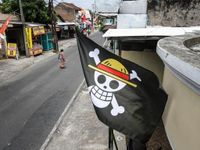Across Indonesia, a new symbol has captured the public imagination—and, not coincidentally, the attention of the nation’s leaders. It’s not a political party’s banner or the familiar red-and-white of the national flag. Instead, it’s the Jolly Roger pirate flag from the anime One Piece, a skull and crossbones topped with a straw hat, that has become the unlikely standard-bearer for a wave of public protest and dissatisfaction.
This cartoon pirate flag, once the emblem of Monkey D. Luffy’s fictional crew, now flutters from homes, trucks, and even boats throughout the archipelago. It’s been spotted alongside the national merah-putih during Independence Day celebrations, a juxtaposition that speaks volumes. According to KBA News, communication expert Puji Rianto of Universitas Islam Indonesia sees the phenomenon as far from accidental. "This is part of a continuum of citizen protest that began long before. Today it’s the pirate flag; before, it was slogans like ‘Indonesia gelap’ (dark Indonesia) or ‘kabur aja dulu’ (just run away first). All of it is public criticism of how the country is run," Puji said on August 7, 2025.
This creative wave of protest, Puji argues, is rooted in a deep sense of frustration with perceived injustice, corruption, poverty, and ignorance. The pirate flag, in its original pop culture context, stands for resistance to unjust rulers—a sentiment that has clearly resonated with many Indonesians. Notably, the flag is often displayed beneath the national colors, signaling that the protest is not against the Republic itself, but against those seen as betraying its ideals.
The context for this unusual act of dissent is a period of economic and political strain. As reported by international outlets, Indonesia marked its 80th year of independence from Dutch colonial rule on August 16, 2025, but the mood was far from celebratory for many. Rising prices, youth unemployment at a worrying 16 percent, and a pervasive sense of governmental incompetence have fueled public anger. Radityo Dharmaputra, a lecturer in international relations, noted that the adoption of the pirate flag as a protest symbol highlights a growing dissatisfaction, especially among the younger generation. A recent survey found just 58 percent of young Indonesians optimistic about government economic strategies—a figure that lags behind neighboring Southeast Asian countries.
This isn’t the first time Indonesians have turned to creative protest. Before the pirate flag, the "Indonesia Gelap" or "Dark Indonesia" movement had gained traction. Citizens used the hashtag #IndonesiaGelap to voice frustration over government decisions like budget cuts and controversial laws expanding military influence in civilian affairs, sparking student-led demonstrations nationwide.
The pirate flag’s journey from anime fandom to protest tool began among truck drivers, who flew it in opposition to new regulations. Its use has since expanded, crossing social and economic divides. For Adi, a truck driver from East Java, the flag is a deeply personal statement. He told reporters that it symbolizes his disappointment not only with economic conditions but also with the lack of justice for victims of a deadly crowd crush at a football match in October 2022. "The flag symbolizes my disappointment in government responses to both societal and personal tragedies," Adi explained.
Government reactions to the movement have varied, sometimes cautious, sometimes heavy-handed. On August 5, 2025, State Secretary Minister Prasetyo Hadi, speaking for President Prabowo Subianto, said flying the pirate flag is acceptable—as long as it is not placed alongside or opposed to the national flag. This nuanced stance, however, has not been universally echoed. Budi Gunawan, the coordinating minister for political and security affairs, warned of "criminal consequences" for those who raise the pirate flag, equating it with disrespect for national symbols. Deputy House Speaker Sufmi Dasco Ahmad argued that the displays were designed to create division among Indonesians.
Yet, some experts and activists have cautioned the government against overreaction. Constitutional law expert Prof. Dr. Djohermansyah Djohan urged calm, stating that the government should not brand the movement as treason. He emphasized that Indonesia’s constitution guarantees free expression, and the pirate flag phenomenon is neither a threat nor an act of subversion. "The government should take pride in a public capable of protest that is active, critical, subtle, and non-violent," Djohan asserted, contrasting Indonesia’s freedoms with the repression seen in countries like Myanmar.
Further, Brawijaya University scholar Dr. Verdy Firmantoro described the flag trend as a modern political metaphor—a "new language" of political expression rooted in pop culture. For many, he said, formal political channels feel distant or unresponsive, so memes, T-shirts, and flags become vehicles for criticism. "This is a constructive movement if it demands public policy improvements," Verdy said, noting that youth engagement shows a population not apathetic, but invested in Indonesia’s future. He also warned of potential "dark riders" seeking to exploit the trend for their own agendas, underscoring the need for careful distinction and a wise, measured government response.
Despite warnings and occasional crackdowns—confiscated flags, questioning of individuals—flying the pirate flag remains legal. Many citizens continue to display it openly, undeterred by official threats. Yohanes Sulaiman, another lecturer in international relations, observed that the government’s aggressive stance may have backfired, amplifying the flag’s visibility at a time when unity is typically celebrated.
International human rights advocates have weighed in as well. Usman Hamid, executive director of Amnesty International Indonesia, condemned threats against those who raise anime flags. He reaffirmed the importance of freedom of expression, saying, "The actions reflect a creative outlet for citizens expressing their discontent and should not be seen as treasonous."
The symbolism has even reached the highest levels of government. During the presidential debates, Vice President Gibran wore a Jolly Roger pin, a move seen as paradoxical since his father was president at the time. Puji Rianto cautioned against oversimplifying such acts as rebellion, warning that ignoring the deeper meaning could escalate unrest into mass disobedience.
As Indonesia grapples with economic uncertainty and political disillusionment, the One Piece pirate flag stands as a vivid, if unconventional, emblem of resistance and hope. Whether this movement marks a fleeting moment or a turning point in the nation’s political culture remains to be seen. But for now, the pirate flag’s message is clear: Indonesians are watching, speaking out, and demanding better from those who govern in their name.




